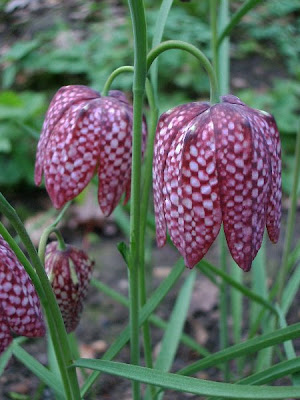The Snake's Head Fritillary is a darling amongst late spring bulbs but it happens to be a bit of an oddity. Despite its exotic appearance this intractably patterned plant is a native to Great Britain and unlike most bulbs – whose natural habitats tend to be nutrient poor soils with low moisture availability – this species prefers the damp environments of traditional meadows and pastures.

Up until the beginning of the 20th century, meadows of fritillaries were common place around Britain but many of these areas were seriously affected during the “Ploughing for Victory” campaign of the Second World War.
In an attempt to further increase food production much of our boggy pasture land was drained for agricultural use and this significantly reduced the overall number of sites which could support these beautiful plants.
Today there are only three sites remaining - notably in Oxfordshire - where you can still find the Snake’s Head fritillary in its natural habitat.
Although now a protected species and rarely found in the wild the Snakes Head Fritillary is readily available from cultivated stock either as bulbs in late autumn or as pot grown stock in the spring. In the garden they are tolerant of most soil types so long as they are kept moist. However, if you intend to naturalise them you should try for a neutral to slightly alkaline soil in a sunny or partially shaded position. If the soil is too free draining add plenty of humus such as leaf mould, but the most important condition that is required for successful naturalisation is to not allow them to dry out over the spring and summer period.
Growing the Snake's Head Fritillary from seed
As a native to Britain, the Snake's Head Fritillary– Fritillariameleagris is relatively easy to propagate.
This can be done either by division when the bulbs are dormant at the end of the summer, or by collecting and sowing viable seed
When propagating from seed, collect it as soon as they ripen – around June or July - otherwise dormancy can set in and it can then take a year or so before germination occurs.
Before you sow your seed however, you will need to make a change in your seed compost recipe in order to help optimise the germination results. Simply make up a mix of 1 part perlite or horticultural grit to 2 parts John Innes seed compost.
Sow them thinly – as this will avoid the need to prick out the delicate seedlings later, and then cover the seed with a thin layer of compost carefully adding no more than ¼in of horticultural grit on top. Place outside in a shady spot, but open to the weather and if you have collected the seed early enough germination can start to occur as soon as 1 month.
Before you sow your seed however, you will need to make a change in your seed compost recipe in order to help optimise the germination results. Simply make up a mix of 1 part perlite or horticultural grit to 2 parts John Innes seed compost.
Sow them thinly – as this will avoid the need to prick out the delicate seedlings later, and then cover the seed with a thin layer of compost carefully adding no more than ¼in of horticultural grit on top. Place outside in a shady spot, but open to the weather and if you have collected the seed early enough germination can start to occur as soon as 1 month.
It's important to keep the compost moist throughout the summer and once most of the seeds have germinated, they can be moved into a cold-frame or well lit spot in the garden. At this point they can be given an occasional liquid feed as this will help to prevent problems with loss of nutrients due to leaching. Grow them on for at least another year before transplanting out into a moist, semi shaded position in August when the plants become dormant.
For further information on other bulb and tuberous plants click onto:
Dahlia 'Bishop of Llandaff'
Dahlia Pests and Diseases
Dahlia 'War of the Roses'
Dracunculus vulgaris - The Dragon Lily
How do you Over-Winter Begonia Corms?
How to Grow Crocus from Seed
Growing Geraniums from Seed
How to Grow Dahlias from Seed
How to Grow Lobelia from Seed?
How to Grow Species Tulips from Seed
How to Grow the Saffron Crocus
How to Over-Winter Dahlia Tubers
How to Over-Winter Rare and Species Tulips
How to Over-Winter the Glory Lily
How to Plant and Grow Daffodils
How to Plant and Grow Dahlias
How to Plant and Grow Hyacinths
How to Plant and Grow Snowdrops
How to Plant and Grow the Glory Lily
How to propagate Daffodils and Narcissus
How to Propagate Dahlias
How to Propagate Hyacinths
How to Propagate Snowdrops
How to Propagate the Saffron Crocus
How to Propagate the Snake's Head Fritillary
How to Propagate Tulips
Lilium Nepalense - the Lily of Nepal
Lost Tulips of the Dutch Golden Age- Semper Augustus and Viceroy
Old, Broken and Unusual Tulip Varieties
Old Dutch Tulips - Tulip 'Absalom'
Old Dutch Tulips - Tulip Duc van Thol 'Rose'
Saffron
Species Tulip - Tulipa acuminata
Species Tulip - Tulipa Turkestanica
Species Tulip - Tulipa wilsoniana
Tetrapanax papyrifera 'Rex'
The Bat Plant
The Glory Lily - Gloriosa rothschiliana
The Mushroom
The Snake's Head Fritillary - Fritallaria meleagris
The Saffron Crocus - Crocus sativus
The White Bat Plant - Tacca integrifoilia
Top Tips For Tulip Care
Tulip Diseases
Tulip History and Popular Varieties
Tulipa 'Rem's Sensation'
Tulip 'Semper Augustus' - does it still exist?
What is a Bulb?
Images care of http://www.annbrooksphotography.com/pages/natural-world-gallery/plants.php?gall_id=34 and http://hedgerowrose.com/annuals-perennials/bulbs/2011/09/24/my-top-5-must-have-bulbs-for-fall-planting-and-spring-bloom/


























